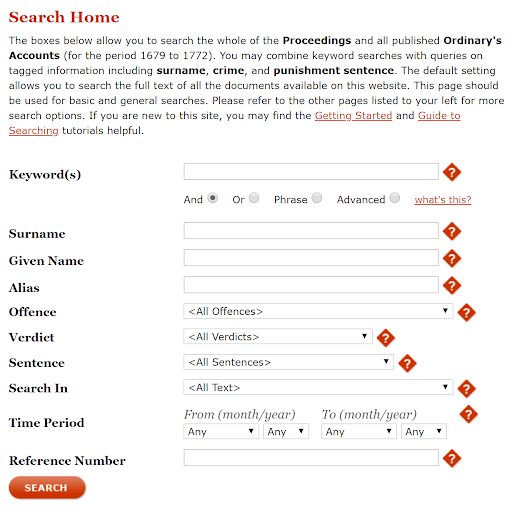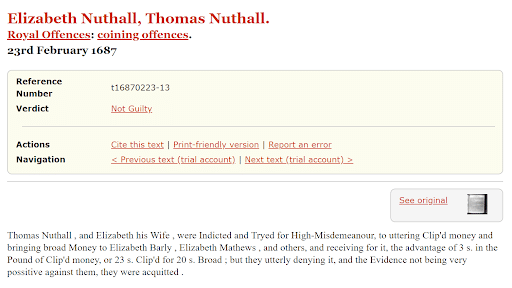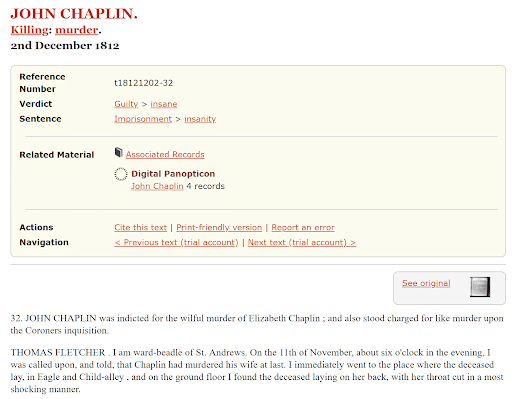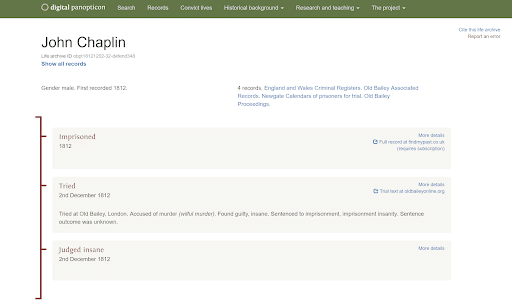You don’t have to have murderers or famous outlaws in your family tree to make use of criminal records in your research. If you have ancestors who lived in England in the last three and a half centuries you do not want to miss the vast (and free) collections of The Old Bailey Online and its sister site the Digital Panopticon.
These fascinating pages hold some of the largest collections of “non-elite” people ever published – with records of nearly 200,000 proceedings of the Old Bailey Courthouse in London, which has been in operation for over 400 years.
Here, you’ll be able to search your ancestors’ names to see if they were included in court cases of every possible type – from petty theft that led to transportation to heinous crimes with heinous punishments (and some with no punishments at all). And your ancestor doesn’t have to have been the perpetrator to be included. The Old Bailey project also indexed the names of victims of these crimes, as well as accusers, witnesses, and family members.
While The Proceedings of the Old Bailey online hold the trial records, the Digital Panopticon attempts to build a story around the lives of these individual convicts by connecting them to other databases – including additional criminal records and censuses.
Old Bailey Online and How to Use It
The Old Bailey’s location near Newgate prison, between the cities of London and Westminster, made it a convenient spot for trying individuals from a wide geographical range north of the river Thames. Crimes prosecuted at the Old Bailey included felonies and misdemeanors ranging from “vagabonding” (begging) to murder.
From 1674 to 1913, trials taking place at the Old Bailey were regularly published in a series of periodicals known as “The Proceedings.” The earliest Proceedings pamphlets served primarily as a form of entertainment for the masses, but eventually became more formal in nature. The publication was no longer needed when the government began requiring its own staff to provide full shorthand notes of trials in 1913.
In the early 2000s, a handful of educational and humanities organizations obtained grants to digitize all of the published records contained in these publications. Since then, more than 190,000 pages of The Proceedings have been digitally imaged, as well as 4,000 pages from the “Ordinary of Newgate’s Accounts,” which published biographies of executed Newgate prisoners from 1676 to 1772.
In total, the website includes records of more than 197,745 criminal trials, plus 2,500 biographies from the Ordinary publications. Additionally, the website is fully indexed and searchable, with transcripts as well as original images. The creators of the site have included multiple search options for both people and topics, and have even provided helpful video tutorials to get you started.
For example, if you’d like to review all cases of treason, every case in which the verdict was not guilty by reason of “non compos mentis,” or the cases that resulted in a sentence of “death and dissection,” you can select these options from one of the drop-down menus.
The search functionality also includes options for surname, given name, and even an alias, as well as certain time periods. For family historians, the sheer volume of information and ease of access to this original data is incredibly exciting.
Searching for Members of Your Family Tree in the Old Bailey Records
My ancestors include the Nuthall family, who lived in the London/Middlesex area in the 1600s, so I wanted to research any mentions of this name within the Old Bailey records. I entered “Nuthall” into the Surname field, left the other fields blank, and hit the Search button.
Eight results were displayed. Although I didn’t recognize any of the given names as those I’d added to my personal family tree, I couldn’t resist checking out at least the first listed case, which was a 1687 “coining offence” against Elizabeth and Thomas Nuthall.
Each case is assigned a reference number, which is another option you can use for future searches. The verdict of “Not Guilty” is hyperlinked to a more detailed explanation of the term as it was interpreted at the time. You can also click on “See original” to view the case as it was originally printed in The Proceedings periodical.
Next, I wanted to learn more about the offense that’s referred to in the text as “uttering clip’d money.” Luckily, the Old Bailey site includes an incredible amount of explanation and context about the various charges of the 17th, 18th and early 19th century that are included in the site.
A quick search of the “Crimes Tried at the Old Bailey” page reveals that “uttering” means “possessing counterfeit money or putting it into circulation.” Fascinating!
Uncovering New Research Leads
There are some great genealogical nuggets to be uncovered in The Old Bailey records. Take the statement below, which is part of the confession of felon John Crudleigh just before his 1710 execution:
From this passage we learn Crudleigh was 32 years old, born near Shrewsbury, moved to London around 1696, and served as an apprentice to a mason.
If Crudleigh was your ancestor, this information could lead you to new discoveries about his immediate family, who may have remained in Shrewsbury after he moved to London.
If there are additional records associated with a case, links to these will be displayed along with the verdict and sentence. For example, there are records associated with John Chaplin’s case, in which he was found guilty of murdering his wife and was sentenced to prison, although he was also determined to be insane.
Clicking the “associated records” link reveals that more information on John Chaplin and his crime is available at The National Archives (UK) in the register of criminal lunatics held at Bethlehem Hospital.
Although this particular register isn’t online at The National Archives’ website, it is available within Ancestry’s subscription database.
The Chaplin verdict also references four related records available for free in the Digital Panopticon.
One of a long list of related digital projects that use the information found in the Old Bailey Proceedings, the Digital Panopticon links the Old Bailey records to a “wide range of punishment records to trace the life experiences and criminal careers of Old Bailey defendants.”
As family historians, we’re sure to love anything that helps us trace life experiences of our ancestors – even if it is involving their criminal lives.
In the case of John Chaplin, the Digital Panopticon indicates that additional information about Chaplin can be found at The Old Bailey site as well as on FindMyPast.
Even if you have no family from England, The Old Bailey website and its related resources could keep any genealogist occupied for hours. The vast amount of information about crime and punishment in the UK from the late 1600s to the early 1900s sheds light on the world in which our ancestors lived. See what you can find on this free genealogy resource today.
The answer to our Facebook question:
Though on the Evidence it seemed to be a Murther (sic), yet on consideration of the whole matter, the Jury brought it in only Manslaughter, for reasons best known to themselves; but craving the benefit of his Clergy he was not able to read, and so received sentence of Death.
11 October 1676. Old Bailey Online
This bolded section from the passage above refers to the Benefit of Clergy – an old practice that allowed a person to prove their association with the church (and to receive a potentially more lenient sentence) if they could read or recite what was known as the “neck verse” from the Bible.
Old Bailey online explains:
Dating back to the middle ages, benefit of clergy was originally a right accorded to the church, allowing it to punish its own members should they be convicted of a crime. In this instance the court did not prescribe any punishment for the defendant and instead handed him over to church officials. Since it was difficult to prove who was affiliated with the church, convicts who claimed benefit of clergy were required to read a passage from the Bible. Judges usually chose verses from the 51st Psalm, which was termed the “neck verse”, since it saved many people from hanging.
Read more about the Benefit of Clergy here.
You may also like to read:
- Could You Have Criminal Ancestors? 20 Captivating Genealogy Sites to Help You Find Out
- The Absolute Beginner’s Guide to Researching Your Ancestors in England, Wales, Scotland or Ireland
- 12 Genealogy Sites You Must Search If You Have UK Ancestors
By Patricia Hartley. For nearly 30 years Patricia has researched and written about the ancestry and/or descendancy of her personal family lines, those of her extended family and friends, and of historical figures in her community. After earning a B.S. in Professional Writing and English and an M.A. in English from the University of North Alabama in Florence, Alabama, she completed an M.A. in Public Relations/Mass Communications from Kent State University.
Image: LONDON: OLD BAILEY, c1750. The scaffold at the Old Bailey in London, England. Copper engraving, c1750. Granger Historical Picture Archive









